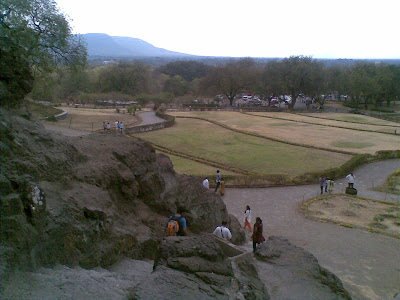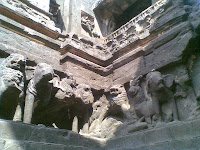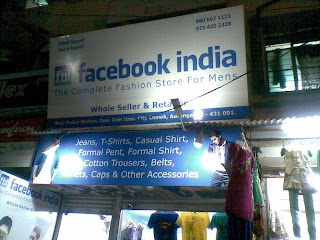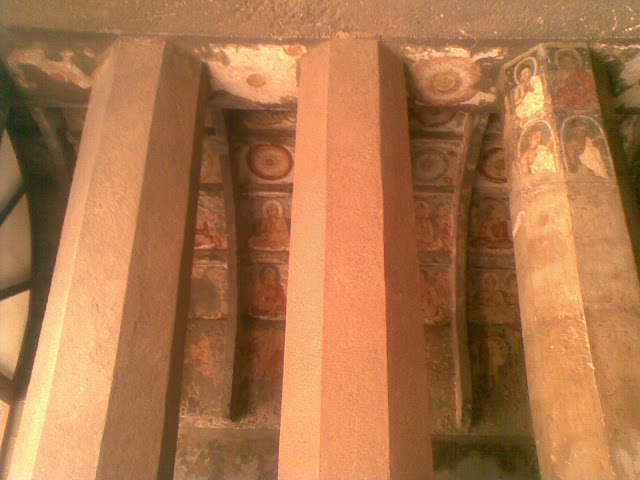It's taken me a fair bit of time to even begin to write about this trip. Of course, it was overwhelming and a lot to document at one go, but I realised this was a travelogue, not a user manual.
So Ajanta & Ellora – the two UNESCO classified World Heritage Sites about which more information can be found
ALL OVER THE INTERNET had suddenly surfaced on our Maharashtra-trips radar for the simple fact that we indeed wanted to travel, but the beaches were getting too hot to handle and too expensive – not to mention the lack of being able to strip into your bare minimums and saunter around (c’mon pardon my first world problems, will ya’?).
The buses to Aurangabad were surprisingly cheap – however if you are a boy-girl duo travelling anywhere in India, I suggest either book yourself into a very fancy 5 star or carry a fake marriage certificate, if you don’t have a real one. Sorry, but in India, we are fine gaping at even fully clad women but not with another man. No sir.
But as always, the feminist Jhansi ki Raani in me digresses.
.jpg) |
| We didn't begin too early in the day - by the time we were at Ellora, the clouds were our only protectors! |
We divided the trip across two days with Saturday for Ellora and Sunday for Ajanta – or Ajintha, as you will discover on the signboards. Aurangabad itself is like every other city that the Moghuls ever touched. Sturdy grand gates with their elegant pointy arches, with little or no ornamentation, but plenty to awe.
.jpg) |
| The comparatively easy and planar walk at Ellora; entrance visible in the distance |
 |
Silhouette of the monolithic pillar
at the entrance of Ellora's cave #16 |
But this story still hasn’t begun. We wondered if our Couchsurfing karma had matured enough to pay yet, and tried our luck with Joshua – the journalism student from Kenya studying in Aurangabad. Joshua Boitt couldn’t have done more than he did for us. Not only did he make sure we had a warm place to sleep, but also one that was free from mosquitoes! He let me cook classic Indian fare in his kitchen (on a fancy automatic stove!) and gave us the experience of eating with a warm bunch of friends over some conversation and laughter. His roommate, John too kept us company. In fact, he insisted he cook us something Kenyan too – and made this sooji-halwa kind’a preparation – except it had nothing but water and broken rice – no salt, no sugar, no nothing. Needless to say, to our spice and salt-bomb accustomed tastebuds, it was nothing short of vile. However, they tried and we couldn’t have said on their faces that it sucked. Rao even downed it like a good boy. I reckon I’m a tad less tolerant.
It was then that I realised how contagious the disease of hospitality is. Whether you are a guest of India for a few odd years, or an Indian far away, you just can’t help host like a pro when there’s an Indian somewhere in the whole circuit.
And to top it, Josh made sure we were two well-fed children at breakfast so our travails would not be hindered by oddities such as hunger! He even noticed the chain with the filigree pendant on it that I had on – my grandmother’s, when I told him, he smiled.
Ellora was our first experience of sheer open-mouthed wonder. The very first cave you see there – #16 – is a temple complex carved out of one solo rock. How they cut metres of rock vertically with such geometric precision all those centuries ago is what leaves you staring at the heavens – and to the top most part of the atrium.
.jpg) |
| The Mahadev temple at Ellora |
.jpg) |
| Cut to precision: Ellora |
.jpg) |
| Very oriental lions at Ellora |
And while Ellora is an easier linear walk to the left and a slight climb on the right, it was Ajanta that felt even more worth our while. 3/4 of a horseshoe, the caves have been carved out from a natural ‘U’ shaped hillock of rock along the river Waghora in Maharashtra. The very first climb up is just of feeler of things to come. As you proceed further, there are all sorts of climbs up and down, gradual and steep. And this is where you discover far more intricate forms of the two arts in their resplendent display – sculpture and painting. The vegetable dye paintings have lasted over a couple of centuries, and the sharpness and attention to detail threaten to take your breath away. With much of the depletion of the paintings caused by flash photography, I don’t blame the ASI having banned it. But if you have a great digital SLR that can withstand a moving hand and produce some good photos with prolonged exposure, you will have captured something that peaked over 2000 years ago.
.jpg) |
| Intricate & uniform |
Ellora and Ajanta have also been maintained surprisingly well. I reckon just as the Golconda in Hyderabad or any other place of archaeological heritage under the UN’s straight supervision, this one too has been spent upon. A sense of pride and reflection fills you. We saw a foreigner reading right outside the caves at Ellora under a tree. His sense of calm flummoxed me. At the time, I thought, what a man to come so far and sit here to read. Now I see what he did – a sense of gratitude towards those who built something so strong and beautiful that all this time later, we in our retarded sense of what is precious, can sit and enjoy still.
.jpg) |
| Cathedral, Ellora |
But the trip in itself was a humbling one. Our host Joshua lives on one side of the outskirts of Aurangabad in a fairly newly constructed tenement. From his terrace is visible a huge horseshoe of hills on three sides. On the fourth, where the terrain dips towards the river, you see the Rani ka Maqbara. Apparently a miniature version of the Taj Mahal built by Aurangzeb (possibly in some fit of juvenile competitiveness to his ancestors), this one presents a soothing view to the eyes. By night, when the stars light up the sky, or perhaps when the moon shines on the horizon, I’m sure the Maqbara looks nothing short of charming.
.jpg) |
| Quirky Aurangabad! |
But as is the case with every city with a considerable and prominent Muslim population, Aurangabad also has an aromatic culture of food. We ate our last meal at Sagar – Rao was too sold on the idea of Naan Quaila and it was ordered. The influence of rich Mughal cuisine is high on the dish – but so is the spice of the Maharashtrian interiors belt.
.jpg) |
| Cathedral with painted frescos, Ajanta |
All in all, if you’re in for a new experience with the ancient, do it differently – register with Couchsurfing, book on RedBus, meet a few strangers and load up on the food you get. The memory – that’s how it becomes something of a capsule to last forever!
.jpg)
.jpg)

.jpg)
.jpg)
.jpg)
.jpg)
.jpg)
.jpg)
.jpg)

.jpg)